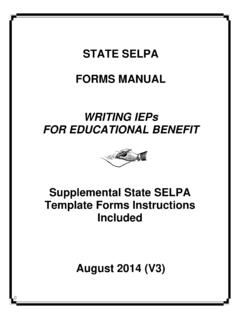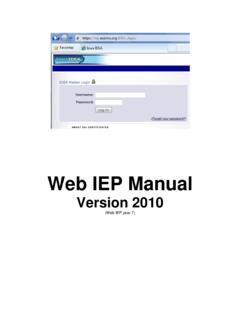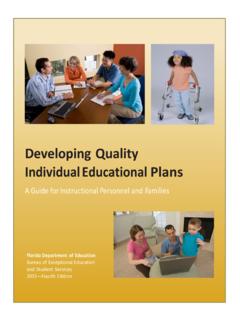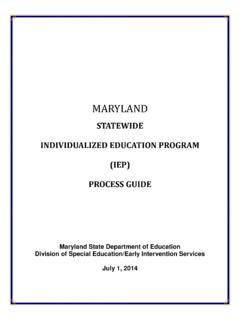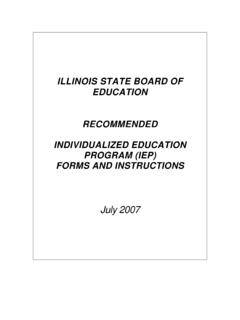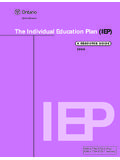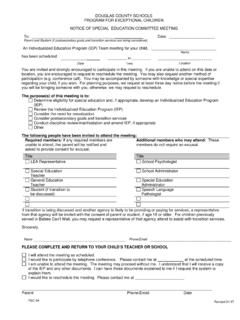Transcription of Individualized Education Program (IEP) Handbook
1 Care Parent Network 1 7/12 INTRODUCTION This Handbook gives an overview of special Education for parents of children with disabilities. Its purpose is (1) to familiarize you with special Education law that governs your child s Education in the public school system, (2) to inform you of your rights and responsibilities under special Education law, and (3) to help you participate in the special Education process as an advocate for your child. The foundation for federal special Education legislation is Public Law 94-142, the Education for All Handicapped Children Act of 1975. It required that children with disabilities age three to twenty-two receive appropriate Education , which, before its passage, millions of children had not been receiving.
2 The law made parent involvement central to the special Education planning process. The Education for All Handicapped Children Act of 1975 was re-authorized in 1990 and renamed the Individuals with Disabilities Education Act (IDEA). IDEA was re-authorized in 1997 and again in 2004 (and renamed the Individuals with Disabilities Education Improvement Act, still commonly referred to as IDEA). IDEA mandates early intervention and special Education services for eligible children from birth until they turn 22. Part C governs early intervention services from birth to a child s 3rd birthday. Part B governs special Education services from age 3 until a child turns age 22 or graduates from high school.
3 IDEA provides important protections and rights: 1. EVERY child is entitled to a free, appropriate public Education (FAPE). 2. Identification of children for special Education and evaluations to determine eligibility for special Education must be nondiscriminatory. 3. All children with disabilities who are eligible for special Education services will have an Individualized Education Program (IEP) that is designed to provide each student with an Individualized , meaningful educational Program . 4. Children with disabilities have the right to be educated to the maximum extent possible with peers without disabilities ( in the least restrictive environment or LRE). 5. Parents have due process rights and can challenge decisions of the school system in hearings.
4 6. Parents or guardians and students can participate in educational decision-making and the development of an Individualized Education Program (IEP). Individualized Education Program (IEP) Handbook TABLE OF CONTENTS Introduction & Important rights under IDEA ..1 Steps in the Individualized Education Program (IEP) Process (flow chart)..2 Beginning the Special Education Process o o o Helpful information for reviewing an assessment o Eligibility for Special Education Developing the Individualized Education Program (IEP) o The IEP o The IEP o The IEP Signing and implementing the If There Are o Informal problem o Facilitated IEP o Due o Compliance Being an Effective Advocate for Your Other Laws Related to Persons With Summary of Some Important Parents Rights Under School Districts in Contra Costa Care Parent Network 2 7/12 Referral for evaluation for special Education services Assessment plan developed by school district within 15 days of date of referral Parents consent to assessment plan within 15 days of receiving plan from the district Assessment, eligibility determination.
5 And IEP development within 60 days of consent for assessment by parents Special Education services start as soon as possible after parents sign IEP (typically within two weeks) Review and modification of IEP at least once a year or as requested by parents or school district Steps in the IEP Process Care Parent Network 3 7/12 BEGINNING THE SPECIAL Education PROCESS Referral The special Education process begins with a referral for evaluation to determine a child s eligibility for special Education services. Parents or school district staff may refer a child for evalution. Parents should always make referrals in writing. Your referral should be addressed to the principal of your child s school or to another appropriate school district administrator ( Director of Special Education ), and it should state why you are concerned about your child s learning and why you are referring your child for evaluation for eligibility for special Education services.
6 Your child s health care provider and teachers may be able to provide you with information that will help you describe specific concerns you have about your child. Evaluation When the school district receives a referral for evaluation for special Education services, they have 15 calendar days (not including school breaks of 5 days or more) to develop a plan to assess your child s educational needs and to send it to your for your review and consent. Even if your child has already been diagnosed with a disability ( autism, Down Syndrome), the school must still evaluate your child to get information about her strengths and areas of educational need in order to make decisions about appropriate educational services.
7 The assessment plan must address all areas of suspected disability, so it is important to make sure that all of your concerns will be addressed by the planned assessments. If you have concerns about your child s educational needs that will not be addressed by the planned assessments, it is important to share your concerns with the school district and to provide specific reasons (observations) to support your concerns, so that your child can be assessed in any additional areas of need that you have identified. Once you receive the assessment plan from the school district, you have 15 calendar days to review the assessment plan, talk to the evaluators, and get any additional information you need before deciding whether or not to give your consent for assessment.
8 You may give consent to all, part or none of the assessment plan. The school district may not assess your child for special Education services without your written consent. If you consent to the assessment plan, the school district has 60 calendar days (not including school breaks of 5 days or more) to complete the assessment of your child and to hold an IEP ( Individualized Education Program ) meeting to discuss your child s eligibility for special Education services and to develop an IEP, if your child is determined to be eligilble for special Education services. When the assessment process has been completed, each professional will write a report describing the assessment results, and copies of these reports must be provided to the parents.
9 You should request to receive the reports before the IEP meeting that you have enough time to read the reports and ask any questions that you may have. You have the right to challenge any results you feel are inaccurate, Some helpful things to know In reviewing the assessment plan: Your child must be assessed in all areas of suspected disability. Assessment procedures must be non-discriminatory and must be appropriate for your child s age, level of functioning, attention span, and type of disability or suspected disability. There must be more than one assessment procedure used. All assessments must be carried out in the primary communication mode that your child uses ( sign language, language other than English, communication device, Braille, etc.)
10 District staff must have appropriate credentials, licenses, and qualifications needed to administer the assessments. Assessment results are confidential. Assessment vs evaluation: assessments provide information that is used in the evaluation or decision-making process. Care Parent Network 4 7/12 incomplete, or misleading. If you choose, you also have the right to submit written reports of outside assessments, and this information must be considered by the IEP team. If the school district lacks qualified personnel to conduct an assessment, or if you can demonstrate that the assessment is inaccurate, you can request an independent educational evaluation at school district expense.

